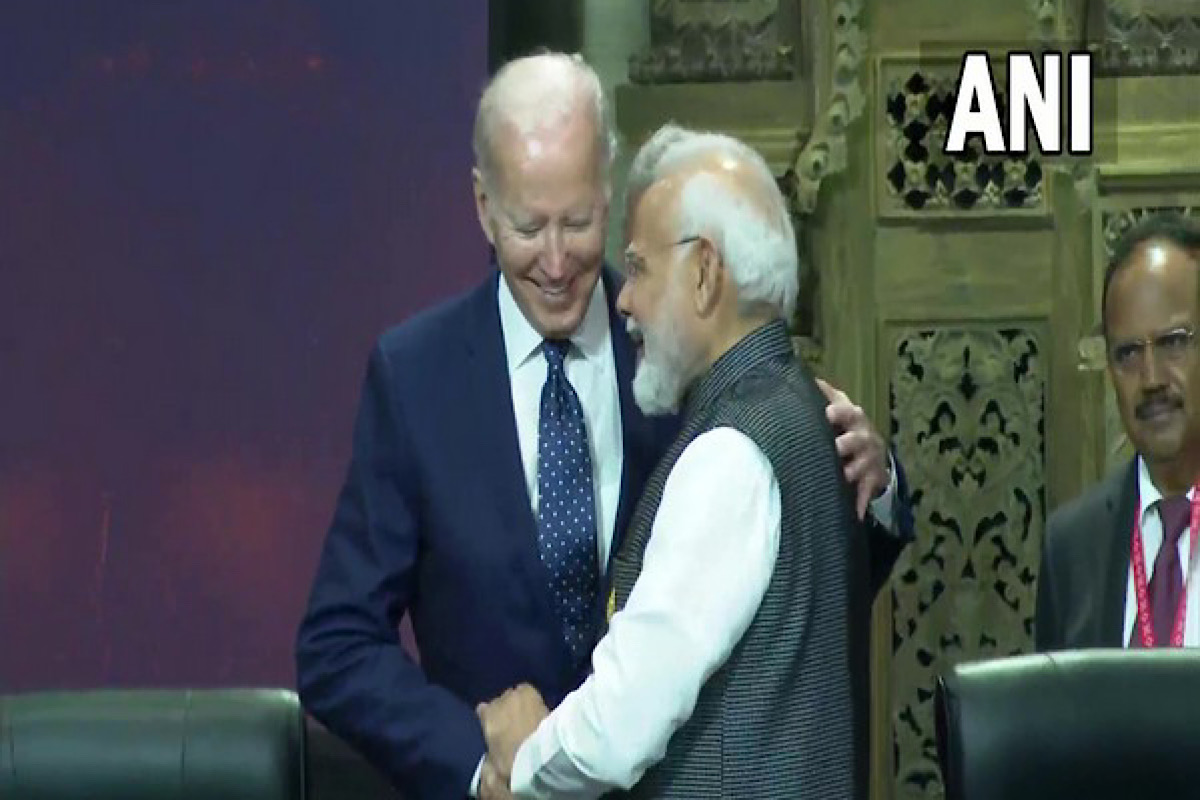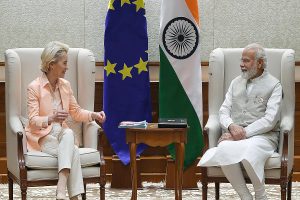Prime Minister Narendra Modi, is the first Indian PM who will address the Joint Meeting of the US Congress for the second time during his upcoming official state visit to the United States from June 21 to 24. The invitation extended to PM Modi reflects the bipartisan respect and support he enjoys in the United States.
Prime Minister Narendra Modi is second only to Benjamin Netanyahu, the PM of Israel, in terms of addressing the Joint Meeting of the US Congress. Netanyahu has achieved this honour thrice. It is noteworthy that a Democratic President Joe Biden is inviting the Indian Prime Minister for a White House state dinner, while a Republic Speaker has asked him to address the joint session of Congress, indicating bipartisan support for augmenting Indo-US ties, Modern Diplomacy.eu reproted.
Advertisement
This honour to PM Modi shows that this type of opportunity is granted only to the closest allies of the United States.
Upon his arrival, Modi will receive an official welcome and hold bilateral meetings and delegation level talks. President Joe and First Lady Jill Biden will be hosting a state dinner in his honour. In a singular opportunity granted only to the closest allies of the United States, Modi will be addressing a joint session of the American Congress during his visit to the States, Modern Diplomacy.eu reproted.
The US-India relations have grown exponentially since Narendra Modi came to power almost a decade ago, security and economic links with the US have enhanced conspicuously, alongside deepening security cooperation like counterterrorism around shared interests limiting China’s influence in the broader Indo-Pacific.
Meanwhile, The Biden administration has sought to further broaden the scope of the strategic partnership between the two countries and deepen Indian integration into a shared security architecture after having two decades of deepening strategic linkages.
White House press secretary announced that “the President and the First Lady are looking forward to welcoming PM Modi for the official state visit on 22nd June. This will be an opportunity to reaffirm the deep and close partnership between US-India.”
State visits at the highest level of protocol are rare in the American system, and PM Modi is just the third state visitor during the Biden Presidency.
Historically, Modi will be the third Indian leader ever invited for a state visit to the US, since those of President Sarvepalli Radhakrishnan in 1963 and Prime Minister Manmohan Singh in 2009. During the state dinner hosted by President Obama for PM Singh, the two leaders spoke augustly about a “future that beckons all of us.”
Modi’s state visit will also be one of the longest of any leader to the US. So, in many ways, this visit is a significant signalling of the prominence that the US accords to its relations with India, Modern Diplomacy.eu reproted.
On the agenda are agreements on trade, defence and critical minerals and significant progression of the Indo-US defence partnership, with the signing of a joint production agreement.
Ahead of Modi’s state visit, US Defence Secretary Lloyd Austin was in India on a two-day visit to explore ways to lay the groundwork for highly anticipated agreements on bilateral defence cooperation, especially in areas of transfer of critical technologies for co-development of military hardware, Modern Diplomacy.eu reproted.
With bilateral trade reaching a record-breaking USD 191 billion last year, US-India Business Council (USIBC) will also be hosting the INDUS-X conference, scheduled over two days in Washington coinciding with Modi’s visit.
After decades of intermittently frigid relations, Washington’s ties with New Delhi have grown significantly closer over the past twenty years. trade and investment flows have grown alongside shared geostrategic interests and China’s growing presence and assertiveness in South Asia and the Indian Ocean region is a concern for both.
President Barack Obama declared India a “major defence partner” and the Trump administration’s growing concerns about China’s regional assertiveness-including along the Sino-Indian border-cemented the US-India security partnership.
India was included alongside the United States, Australia, and Japan as a counterweight to Chinese ambitions in the Quadrilateral Security Dialogue, or the ‘Quad.’
New Delhi and Washington signed COMCASA (Communications Compatibility and Security Agreement) in 2018 which provides for interoperability between the two militaries and provides for the sale of high-end technology from the US to India.
This was followed by the BECA (Basic Exchange and Cooperation Agreement) agreement for sharing of high-end military technology, logistics and geospatial maps between the two countries. The pact provides Billions of dollars in American arms purchases that were finalised by the PM Modi government, Modern Diplomacy.eu reproted.
However, it did not accede to Trump’s demands to stop purchasing the S-400 and other Russian military equipment.
With more robust military cooperation such as the acceleration of joint military exercises, there has also been a revival of the US-India Homeland Security Dialogue, which seeks to strengthen cooperation on cybersecurity, technology, and countering violent extremism.
These security-oriented steps with steps have been complemented by initiatives such as the launching of a Clean Energy 2030 partnership, etc. Both leaders oversaw the launch of the India-US Initiative on Critical and Emerging Technology (ICET) during the Quad Summit in May 2022, Modern Diplomacy.eu reproted.
The signing of the MoU with General Electric deal will be the biggest deliverable of Prime Minister Modi’s State visit to the US. India’s Aeronautical Development Agency (ADA) has selected 99 F414 GE fighter jet engines to power the Mk II version of the Tejas Light Combat Aircraft (LCA) for the Indian Air Force.
One of the most important results of the ICET was the commencement of negotiations on the General Electric (GE) deal to produce GE-F414 jet engines in India, complete with technology transfer.
In February this year, the historic deal between Boeing and Air India for the latter to buy more than 200 planes from the American plane manufacturer was announced. Air India is ordering 220 Boeing aircraft valued at USD 34 billion.
The orders include 190 737 Max aircraft, 20 of Boeing’s 787s, and 10 of its 777Xs. The purchase also includes customer options for an additional 50 737 MAXs and 20 of its 787s, totalling 290 aeroplanes for a total of USD 45.9 billion at the list price.
In a phone call, both leaders discussed the importance of the US-India strategic technology partnership and committed to continue working together and in groups like the Quad to advance economic growth and expand cooperation on their shared priorities, Modern Diplomacy.eu reproted.
GE was engaged by the Biden administration, and a proposal with Hindustan Aeronautics Limited (HAL) officials was arrived at. The agreement is to build GE-F414-INS6 engines that will power Tejas-Mk II Light Combat Aircraft (LCA) being built by HAL.
Although the final details of the agreement will only be clear once the MoU is signed, it is likely that the transfer of technology (ToT) and the percentage of locally manufactured components will exceed 60 per cent, possibly reaching 75 per cent.
Other deliverables include the go-ahead for New Delhi’s plan to procure 30 MQ-9B armed drones at a cost of over USD 3 billion from US defence major General Atomics Aeronautical Systems Inc.
The US is already India’s largest goods trading partner and the only major country with which India has a goods trade surplus. There is also tremendous excitement in the business community over the launch of the initiative INDUS-X, a platform for start-ups and enterprises from both countries to identify collaborations for high-tech innovations within the ambit of the Initiative on Critical and Emerging Technologies (iCET).
Both administrations have shown tremendous excitement for the “defence innovation bridge” of which the GE deal is just one element, Modern Diplomacy.eu reproted.
This news article is written by Vaishali Basu Sharma. She is an analyst of strategic and economic affairs. She has worked as a consultant with India’s National Security Council Secretariat (NSCS) for nearly a decade. She is presently associated with the New Delhi-based think tank Policy Perspectives Foundation.











